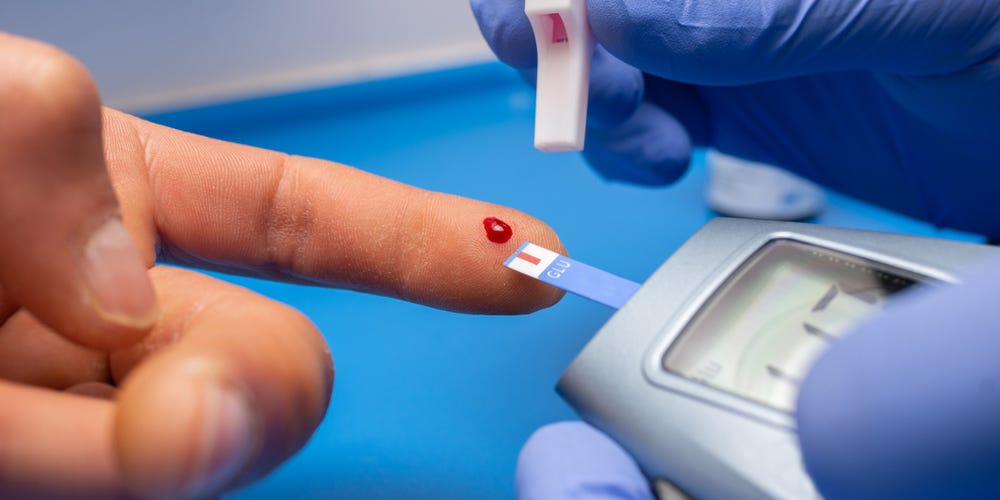How to Know Your Blood Sugar Numbers
PostedAt: Fri, Aug 6, 2021 10:52 AM
Understanding blood glucose level ranges can be a key part of diabetes self-management.Know Your Blood Sugar Numbers: Use Them to Manage Your Diabetes.Also Know About low blood sugar numbers , High blood sugar numbers, High Blood Sugar, Diabetes, and Your Body.
Checking your blood sugar, also called blood glucose, is an important part of diabetes care. This tip sheet tells you:
- why it helps you to know your blood sugar numbers
- how to check your blood sugar levels
- what are target blood sugar levels
- what to do if your levels are too low or too high
- how to pay for these tests
Why do I need to know my blood sugar numbers?
Your blood sugar numbers show how well your diabetes is managed. And managing your diabetes means that you have less chance of having serious health problems, such as kidney disease and vision loss.
As you check your blood sugar, you can see what makes your numbers go up and down. For example, you may see that when you are stressed or eat certain foods, your numbers go up. And, you may see that when you take your medicine and are active, your numbers go down. This information lets you know what is working for you and what needs to change.
Low blood sugar (hypoglycaemia)
A low blood sugar numbers, also called hypoglycaemia or a "hypo", is where the numbers of sugar (glucose) in your blood drops too low.
It mainly affects people with diabetes, especially if they take insulin.
A low blood sugar numbers can be dangerous if it's not treated quickly, but you can usually treat it easily yourself.
Symptoms of a low blood sugar numbers
A low blood sugar numbers can affect everyone differently. You'll learn how it makes you feel, although your symptoms may change over time.
Early signs of a low blood sugar numbers include:
- sweating
- feeling tired
- dizziness
- feeling hungry
- tingling lips
- feeling shaky or trembling
- a fast or pounding heartbeat (palpitations)
- becoming easily irritated, tearful, anxious or moody
- turning pale
If a low blood sugar numbers is not treated, you may get other symptoms, such as:
- weakness
- blurred vision
- confusion or difficulty concentrating
- unusual behaviour, slurred speech or clumsiness (like being drunk)
- feeling sleepy
- seizures or fits
- collapsing or passing out
A low blood sugar numbers, or hypo, can also happen while you're sleeping. This may cause you to wake up during the night or cause headaches, tiredness or damp sheets (from sweat) in the morning.
How to treat a low blood sugar numbers yourself
Follow these steps if your blood sugar numbers is less than 4mmol/L or you have hypo symptoms:
- Have a sugary drink or snack – like a small glass of fizzy drink (not a diet variety) or fruit juice, a small handful of sweets, 3 or 6 glucose tablets or 1 to 2 tubes of glucose gel.
- Test your blood sugar after 10 to 15 minutes – if it's improved and you feel better, move on to step 3. If there's little or no change, treat again with a sugary drink or snack and take another reading after 10 to 15 minutes.
- You may need to eat your main meal (containing a slow-release carbohydrate) if it's the right time to have it. Or, have a snack that contains a slow-release carbohydrate, such as a slice of bread or toast, a couple of biscuits, or a glass of cows' milk.
You do not usually need to get medical help once you're feeling better if you only have a few hypos.
But tell your diabetes team if you keep having hypos or if you stop having symptoms when your blood sugar numbers is low.
How to treat someone who's unconscious or very sleepy (drowsy)
Follow these steps:
- Put the person in the recovery position and do not put anything in their mouth – so they do not choke.
- Call 999 for an ambulance if an injection of glucagon is not available, you do not know how to use it, or the person had alcohol before their hypo.
- If an injection of glucagon is available and you know how to use it, give it to them immediately.
- If they wake up within 10 minutes of getting the injection and feel better, move on to step 5. If they do not improve within 10 minutes, call 999 for an ambulance.
- If they're fully awake and able to eat and drink safely, give them a carbohydrate snack.
They may need to go to hospital if they're being sick (vomiting), or their blood sugar numbers drops again.
Tell your diabetes care team if you ever have a severe hypo that caused you to lose consciousness.
How to treat someone who's having a seizure or fit
Follow these steps if someone has a seizure or fit caused by a low blood sugar numbers:
- Stay with them and stop them hurting themselves – lie them down on something soft and move them away from anything dangerous (like a road or hot radiator).
- Call 999 for an ambulance if the seizure or fit lasts more than 5 minutes.
- After the seizure or fit stops, give them a sugary snack.
Tell your diabetes care team if you ever have a severe hypo that caused you to have a seizure or fit.
What causes a low blood sugar numbers
In people with diabetes, the main causes of a low blood sugar numbers are:
- the effects of medicine – especially taking too much insulin, medicines called sulfonylureas (such as glibenclamide and gliclazide), medicines called glinides (such as repaglinide and nateglinide), or some antiviral medicines to treat hepatitis C
- skipping or delaying a meal
- not eating enough carbohydrate foods in your last meal, such as bread, cereals, pasta, potatoes and fruit
- exercise, especially if it's intense or unplanned
- drinking alcohol
Sometimes there's no obvious reason why a low blood sugar numbers happens.
Very occasionally, it can happen in people who do not have diabetes.
Preventing a low blood sugar numbers
If you have diabetes, you can reduce your chance of getting a low blood sugar numbers if you:
- Check your blood sugar numbers regularly and be aware of the symptoms of a low blood sugar numbers so you can treat it quickly.
- Always carry a sugary snack or drink with you, such as glucose tablets, a carton of fruit juice or some sweets. If you have a glucagon injection kit, always keep it with you.
- Do not skip meals.
- Be careful when drinking alcohol. Do not drink large amounts, check your blood sugar numbers regularly, and eat a carbohydrate snack afterwards.
- Be careful when exercising; eating a carbohydrate snack before exercise can help to reduce the risk of a hypo. If you take some types of diabetes medicine, your doctor may recommend you take a lower dose before or after doing intense exercise.
- Have a carbohydrate snack, such as toast, if your blood sugar numbers drops too low while you're asleep (nocturnal hypoglycaemia)
If you keep getting a low blood sugar numbers, talk to your diabetes care team about things you can do to help prevent it.
A low blood sugar numbers without diabetes
A low blood sugar numbers is uncommon in people who do not have diabetes.
Possible causes include:
- your body releasing too much insulin after eating, (called reactive hypoglycaemia or postprandial hypoglycaemia)
- not eating (fasting) or malnutrition
- a complication of pregnancy
- a gastric bypass (a type of weight loss surgery)
- other medical conditions, such as problems with your hormone numberss, pancreas, liver, kidneys, adrenal glands or heart
- some medicines, including quinine (taken for malaria)
See a GP if you think you keep getting symptoms of a low blood sugar numbers. They can arrange some simple tests to check if your blood sugar numbers is low and try to find out what's causing it.
A low blood sugar numbers and driving
You may still be allowed to drive if you have diabetes or you're at risk of a low blood sugar numbers for another reason, but you'll need to do things to reduce the chance of this happening while you're driving.
You also need to tell the Driver and Vehicle Licensing Agency (DVLA) and your car insurance company about your condition.
Recommended target blood glucose level ranges
The NICE recommended target blood glucose levels are stated below for adults with type 1 diabetes, type 2 diabetes and children with type 1 diabetes.
In addition, the International Diabetes Federation’s target ranges for people without diabetes is stated.
The table provides general guidance. An individual target set by your healthcare team is the one you should aim for.
| Target Levels by Type |
Upon waking | Before meals (pre prandial) |
At least 90 minutes after meals (post prandial) |
|---|---|---|---|
| Non-diabetic* | 4.0 to 5.9 mmol/L | under 7.8 mmol/L | |
| Type 2 diabetes | 4 to 7 mmol/L | under 8.5 mmol/L | |
| Type 1 diabetes | 5 to 7 mmol/L | 4 to 7 mmol/L | 5 to 9 mmol/L |
| Children w/ type 1 diabetes | 4 to 7 mmol/L | 4 to 7 mmol/L | 5 to 9 mmol/L |
*The non-diabetic figures are provided for information but are not part of NICE guidelines.
Normal and diabetic blood sugar ranges
For the majority of healthy individuals, normal blood sugar levels are as follows:
- Between 4.0 to 5.4 mmol/L (72 to 99 mg/dL) when fasting [361]
- Up to 7.8 mmol/L (140 mg/dL) 2 hours after eating
For people with diabetes, blood sugar level targets are as follows:
- Before meals : 4 to 7 mmol/L for people with type 1 or type 2 diabetes
- After meals : under 9 mmol/L for people with type 1 diabetes and under 8.5mmol/L for people with type 2 diabetes
Blood sugar levels in diagnosing diabetes
The following table lays out criteria for diagnoses of diabetes and prediabetes.
| Plasma glucose test | Normal | Prediabetes | Diabetes |
|---|---|---|---|
| Random | Below 11.1 mmol/l Below 200 mg/dl |
N/A | 11.1 mmol/l or more 200 mg/dl or more |
| Fasting | Below 5.5 mmol/l Below 100 mg/dl |
5.5 to 6.9 mmol/l 100 to 125 mg/dl |
7.0 mmol/l or more 126 mg/dl or more |
| 2 hour post-prandial | Below 7.8 mmol/l Below 140 mg/dl |
7.8 to 11.0 mmol/l 140 to 199 mg/dl |
11.1 mmol/l or more 200 mg/dl or more |
Random plasma glucose test
A blood sample for a random plasma glucose test can be taken at any time. This doesn’t require as much planning and is therefore used in the diagnosis of type 1 diabetes when time is of the essence.
Fasting plasma glucose test
A fasting plasma glucose test is taken after at least eight hours of fasting and is therefore usually taken in the morning.
The NICE guidelines regard a fasting plasma glucose result of 5.5 to 6.9 mmol/l as putting someone at higher risk of developing type 2 diabetes, particularly when accompanied by other risk factors for type 2 diabetes.
Oral Glucose Tolerance Test (OGTT)
An oral glucose tolerance test involves first taking a fasting sample of blood and then taking a very sweet drink containing 75g of glucose.
After having this drink you need to stay at rest until a further blood sample is taken after 2 hours.
HbA1c test for diabetes diagnosis
An HbA1c test does not directly measure the level of blood glucose, however, the result of the test is influenced by how high or low your blood glucose levels have tended to be over a period of 2 to 3 months.
Indications of diabetes or prediabetes are given under the following conditions:
- Normal: Below 42 mmol/mol (6.0%)
- Prediabetes: 42 to 47 mmol/mol (6.0 to 6.4%)
- Diabetes: 48 mmol/mol (6.5% or over)
Why are good blood sugar levels important?
It is important that you control your blood glucose levels as well as you can as too high sugar levels for long periods of time increases the risk of diabetes complications developing.
Diabetes complications are health problems which include:
- Kidney disease
- Nerve damage
- Retinal disease
- Heart disease
- Stroke
This list of problems may look scary but the main point to note is that the risk of these problems can be minimised through good blood glucose level control. Small improvements can make a big difference if you stay dedicated and maintain those improvements over most days.
How is blood sugar measured?
There are two ways to measure blood sugar.
- Blood sugar checks that you do yourself. These tell you what your blood sugar level is at the time you test.
- The A1C (A-one-C) is a test done in a lab or at your provider’s office. This test tells you your average blood sugar level over the past 2 to 3 months.
How do I check my blood sugar?
You use a blood glucose meter to check your blood sugar. This device uses a small drop of blood from your finger to measure your blood sugar level. You can get the meter and supplies in a drug store or by mail.
Read the directions that come with your meter to learn how to check your blood sugar. Your health care team also can show you how to use your meter. Write the date, time, and result of the test in your blood sugar record. Take your blood sugar record and meter to each visit and talk about your results with your health care team.
What are target blood sugar levels for people with diabetes?
A target is something that you aim for or try to reach. Your health care team may also use the term goal. People with diabetes have blood sugar targets that they try to reach at different times of the day. These targets are:
- Right before your meal: 80 to 130
- Two hours after the start of the meal: Below 180
Talk with your health care team about what blood sugar numbers are right for you.
How often should I check my blood sugar?
The number of times that you check your blood sugar will depend on the type of diabetes that you have and the type of medicine you take to treat your diabetes. For example, people who take insulin may need to check more often than people who do not take insulin. Talk with your health care team about how often to check your blood sugar.
The common times for checking your blood sugar are when you first wake up (fasting), before a meal, 2 hours after a meal, and at bedtime. Talk with your health care team about what times are best for you to check your blood sugar.
What should I do if my blood sugar gets too high?
High blood sugar is also called hyperglycemia (pronounced hye-per-gly-see-mee-uh). It means that your blood sugar level is higher than your target level or over 180. Having high blood sugar levels over time can lead to long-term, serious health problems.
If you feel very tired, thirsty, have blurry vision, or need to pee more often, your blood sugar may be high.
Check your blood sugar and see if it is above your target level or over 180. If it is too high, one way to lower it is to drink a large glass of water and exercise by taking a brisk walk. Call your health care team if your blood sugar is high more than 3 times in 2 weeks and you don’t know why.
What should I do if my blood sugar gets too low?
Low blood sugar is also called hypoglycemia (pronounced hye-poh-gly-see-mee-uh). It means your blood sugar level drops below 70. Having low blood sugar is dangerous and needs to be treated right away. Anyone with diabetes can have low blood sugar. You have a greater chance of having low blood sugar if you take insulin or certain pills for diabetes.
Carry supplies for treating low blood sugar with you. If you feel shaky, sweaty, or very hungry, check your blood sugar. Even if you feel none of these things, but think you may have low blood sugar, check it.
If your meter shows that your blood sugar is lower than 70, do one of the following things right away:
- chew 4 glucose tablets
- drink 4 ounces of fruit juice
- drink 4 ounces of regular soda, not diet soda or
- chew 4 pieces of hard candy
After taking one of these treatments, wait for 15 minutes, then check your blood sugar again. Repeat these steps until your blood sugar is 70 or above. After your blood sugar gets back up to 70 or more, eat a snack if your next meal is 1 hour or more away.
If you often have low blood sugar, check your blood sugar before driving and treat it if it is low.
What do I need to know about the A1C test?
The A1C test tells you and your health care team your average blood sugar level over the past 2 to 3 months. It also helps you and your team decide the type and amount of diabetes medicine you need.
What is a good A1C goal for me?
For many people with diabetes, the A1C goal is below 7. This number is different from the blood sugar numbers that you check each day. You and your health care team will decide on an A1C goal that is right for you.
How often do I need an A1C test?
You need to get an A1C test at least 2 times a year. You need it more often if:
- your number is higher than your goal number
- your diabetes treatment changes
What Are Normal Blood Sugar Levels?
They're less than 100 mg/dL after not eating (fasting) for at least 8 hours. And they're less than 140 mg/dL 2 hours after eating.
During the day, levels tend to be at their lowest just before meals. For most people without diabetes, blood sugar levels before meals hover around 70 to 80 mg/dL. For some people, 60 is normal; for others, 90.
What's a low sugar level? It varies widely, too. Many people's glucose won't ever fall below 60, even with prolonged fasting. When you diet or fast, the liver keeps your levels normal by turning fat and muscle into sugar. A few people's levels may fall somewhat lower.
Diagnosis
Doctors use these tests to find out if you have diabetes:
- Fasting plasma glucose test. The doctor tests your blood sugar levels after fasting for 8 hours and it’s higher than 126 mg/dL.
- Oral glucose tolerance test. After fasting for 8 hours, you get a special sugary drink. Two hours later your sugar level is higher than 200.
- Random check. The doctor tests your blood sugar and it’s higher than 200, plus you’re peeing more, always thirsty, and you’ve gained or lost a significant amount of weight. They’ll then do a fasting sugar level test or an oral glucose tolerance test to confirm the diagnosis.
Any sugar levels higher than normal are unhealthy. Levels that are higher than normal, but not reaching the point of full-blown diabetes, are called prediabetes.
According to the American Diabetes Association, 86 million people in the U.S. have this condition, which can lead to diabetes if you don't make healthy lifestyle changes that your doctor recommends. It also raises the risk for heart disease, although not as much as diabetes does. It's possible to keep prediabetes from becoming diabetes with diet and exercise.
Sugar and Your Body
Why are high blood sugar levels bad for you? Glucose is precious fuel for all the cells in your body when it's present at normal levels. But it can behave like a slow-acting poison.
- High sugar levels slowly erode the ability of cells in your pancreas to make insulin. The organ overcompensates and insulin levels stay too high. Over time, the pancreas is permanently damaged.
- High levels of blood sugar can cause changes that lead to a hardening of the blood vessels, what doctors call atherosclerosis.
Almost any part of your body can be harmed by too much sugar. Damaged blood vessels cause problems such as:
- Kidney disease or kidney failure, requiring dialysis
- Strokes
- Heart attacks
- Vision loss or blindness
- Weakened immune system, with a greater risk of infections
- Erectile dysfunction
- Nerve damage, also called neuropathy, that causes tingling, pain, or less sensation in your feet, legs, and hands
- Poor circulation to the legs and feet
- Slow wound-healing and the potential for amputation in rare cases
Keep your blood sugar levels close to normal to avoid many of these complications. The American Diabetes Association's goals for blood sugar control in people with diabetes are 70 to 130 mg/dL before meals, and less than 180 mg/dL after meals.
How do I pay for these tests and supplies?
Medicare, Medicaid and most private insurance plans pay for the A1C test and some of the cost of supplies for checking your blood sugar. Check your plan or ask your health care team for help finding low cost or free supplies. Ask your health care team what to do if you run out of test strips. For more information about Medicare and diabetes, go to https://www.medicare.gov/ External link.
What if I have trouble getting to my blood sugar goals?
There may be times when you have trouble reaching your blood sugar goals. This does not mean that you have failed. It means that you and your health care team should see if changes are needed. Call your health care team if your blood sugar is often too high or too low. Taking action will help you be healthy today and in the future.
John's Story
At each visit, John and his health care team look at his A1C test results, his blood glucose meter and his blood sugar record to see if his treatment is working. At today’s visit, John’s A1C and blood sugar numbers are too high. John and his health care team talk about what he can do to get closer to his A1C and blood sugar goals. John decides he will be more active. He will:
- increase his walking time to 30 minutes every day after dinner.
- check his fasting blood sugar in the morning to see if being more active improves his blood sugar.
- call his doctor in 1 month for a change in medicine if his blood sugar levels are still too high.
- have his A1C tested again in 3 months to see if his new plan is working.
Things to remember
- Check your blood sugar as many times a day as your health care team suggests.
- Have your A1C checked at least 2 times a year.
- Keep a record of your blood sugar and A1C numbers.
- Take your blood glucose meter and blood sugar record to your visit and show them to your health care team. Tell your health care team how you think you are doing.
- Call your health care team if your blood sugar is often too high or too low.
Work with your health care team and decide what changes you need to make to reach your blood sugar goals.











